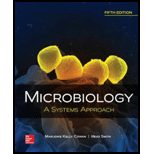
Microbiology: A Systems Approach
5th Edition
ISBN: 9781259706615
Author: Marjorie Kelly Cowan Professor
Publisher: McGraw-Hill Education
expand_more
expand_more
format_list_bulleted
Concept explainers
Question
Chapter 7, Problem 5MCQ
Summary Introduction
Introduction:
Pathogens are the parasitic microorganisms that live inside the body of a host organism and cause damage to tissues, leading to diseases and even death. Pathogens include parasitic bacteria, viruses, protozoa, and helminths. All these organisms contain virulence factors that make them pathogenic and help them in causing infections in the body of the host.
Expert Solution & Answer
Want to see the full answer?
Check out a sample textbook solution
Students have asked these similar questions
Please draw in the missing answer, thank you
Please fill in all blank questions, Thank you
please fill in missing parts , thank you
Chapter 7 Solutions
Microbiology: A Systems Approach
Ch. 7.1 - List the essential nutrients of a bacterial cell.Ch. 7.1 - Prob. 2AYPCh. 7.1 - List and define four different terms that describe...Ch. 7.1 - Define saprobe and parasite, and provide microbial...Ch. 7.1 - Prob. 5AYPCh. 7.1 - Identify the effects of isotonic, hypotonic, and...Ch. 7.1 - Name two types of passive transport and three...Ch. 7.2 - List and define five terms used to express a...Ch. 7.2 - Prob. 9AYPCh. 7.2 - Prob. 10AYP
Ch. 7.2 - Prob. 11AYPCh. 7.2 - Discuss characteristics of biofilms that...Ch. 7.3 - Summarize the steps of cell division used by most...Ch. 7.3 - Define doubling time and describe how it leads to...Ch. 7.3 - Compare and contrast the four phases of growth in...Ch. 7.3 - Prob. 16AYPCh. 7 - The source of the necessary elements of life is a....Ch. 7 - An organism that can synthesize all its required...Ch. 7 - Chemoautotrophs can survive on ______ alone. a....Ch. 7 - Prob. 4MCQCh. 7 - Prob. 5MCQCh. 7 - Prob. 6MCQCh. 7 - A cell exposed to a hypertonic environment will...Ch. 7 - Prob. 8MCQCh. 7 - Prob. 9MCQCh. 7 - In a viable plate count, each _____ represents a...Ch. 7 - Prob. 11TFCh. 7 - Prob. 12TFCh. 7 - Prob. 13TFCh. 7 - Prob. 14TFCh. 7 - A facultative anaerobe can grow with or without...Ch. 7 - Prob. 1CTQCh. 7 - Describe the process used by a saprobic microbe to...Ch. 7 - Prob. 3CTQCh. 7 - Explain what is happening to the bacterial...Ch. 7 - Prob. 5CTQCh. 7 - Prob. 1VCCh. 7 - Using the words that follow, please create a...
Knowledge Booster
Learn more about
Need a deep-dive on the concept behind this application? Look no further. Learn more about this topic, biology and related others by exploring similar questions and additional content below.Similar questions
- please draw in the answers, thank youarrow_forwarda. On this first grid, assume that the DNA and RNA templates are read left to right. DNA DNA mRNA codon tRNA anticodon polypeptide _strand strand C с A T G A U G C A TRP b. Now do this AGAIN assuming that the DNA and RNA templates are read right to left. DNA DNA strand strand C mRNA codon tRNA anticodon polypeptide 0 A T G A U G с A TRParrow_forwardplease answer all question below with the following answer choice, thank you!arrow_forward
- please draw in the answeres, thank youarrow_forwardA) What is being shown here?B) What is indicated by the RED arrow?C) What is indicated by the BLUE arrow?arrow_forwardPlease identify the curve shown below. What does this curve represent? Please identify A, B, C, D, and E (the orange oval). What is occurring in these regions?arrow_forward
- Please identify the test shown here. 1) What is the test? 2) What does the test indicate? How is it performed? What is CX? 3) Why might the test be performed in a clinical setting? GEN CZ CX CPZ PTZ CACarrow_forwardDetermine how much ATP would a cell produce when using fermentation of a 50 mM glucose solution?arrow_forwardDetermine how much ATP would a cell produce when using aerobic respiration of a 7 mM glucose solution?arrow_forward
- Determine how much ATP would a cell produce when using aerobic respiration to degrade one small protein molecule into 12 molecules of malic acid, how many ATP would that cell make? Malic acid is an intermediate in the Krebs cycle. Assume there is no other carbon source and no acetyl-CoA.arrow_forwardIdentify each of the major endocrine glandsarrow_forwardCome up with a few questions and answers for umbrella species, keystone species, redunant species, and aquatic keystone speciesarrow_forward
arrow_back_ios
SEE MORE QUESTIONS
arrow_forward_ios
Recommended textbooks for you

 Concepts of BiologyBiologyISBN:9781938168116Author:Samantha Fowler, Rebecca Roush, James WisePublisher:OpenStax College
Concepts of BiologyBiologyISBN:9781938168116Author:Samantha Fowler, Rebecca Roush, James WisePublisher:OpenStax College- Basic Clinical Lab Competencies for Respiratory C...NursingISBN:9781285244662Author:WhitePublisher:Cengage
 Biology: The Dynamic Science (MindTap Course List)BiologyISBN:9781305389892Author:Peter J. Russell, Paul E. Hertz, Beverly McMillanPublisher:Cengage Learning
Biology: The Dynamic Science (MindTap Course List)BiologyISBN:9781305389892Author:Peter J. Russell, Paul E. Hertz, Beverly McMillanPublisher:Cengage Learning



Concepts of Biology
Biology
ISBN:9781938168116
Author:Samantha Fowler, Rebecca Roush, James Wise
Publisher:OpenStax College

Basic Clinical Lab Competencies for Respiratory C...
Nursing
ISBN:9781285244662
Author:White
Publisher:Cengage


Biology: The Dynamic Science (MindTap Course List)
Biology
ISBN:9781305389892
Author:Peter J. Russell, Paul E. Hertz, Beverly McMillan
Publisher:Cengage Learning